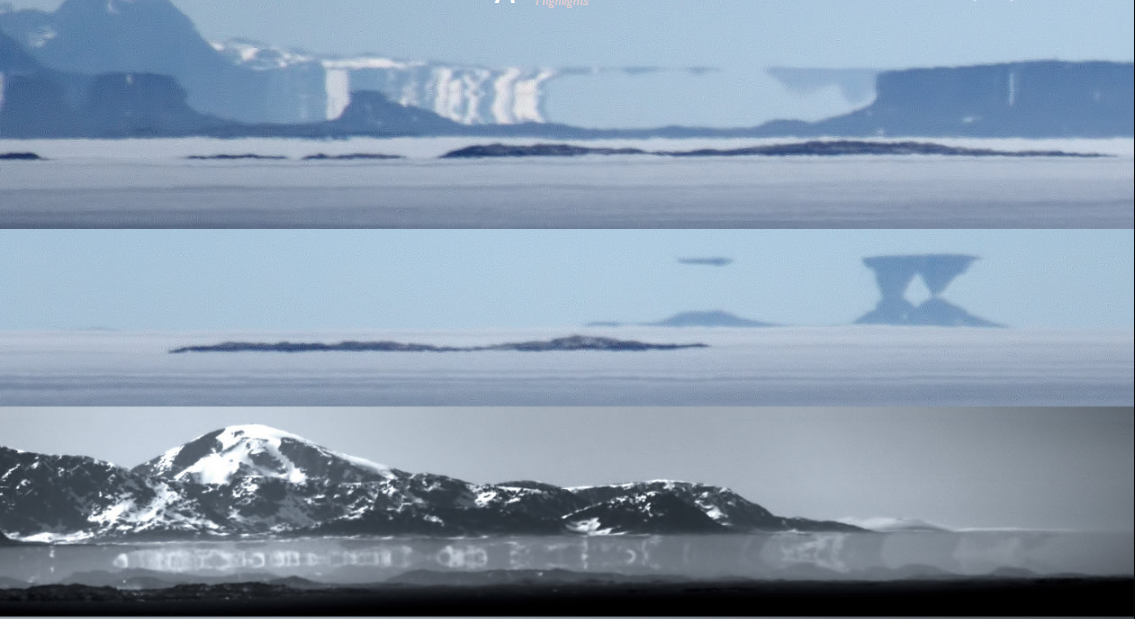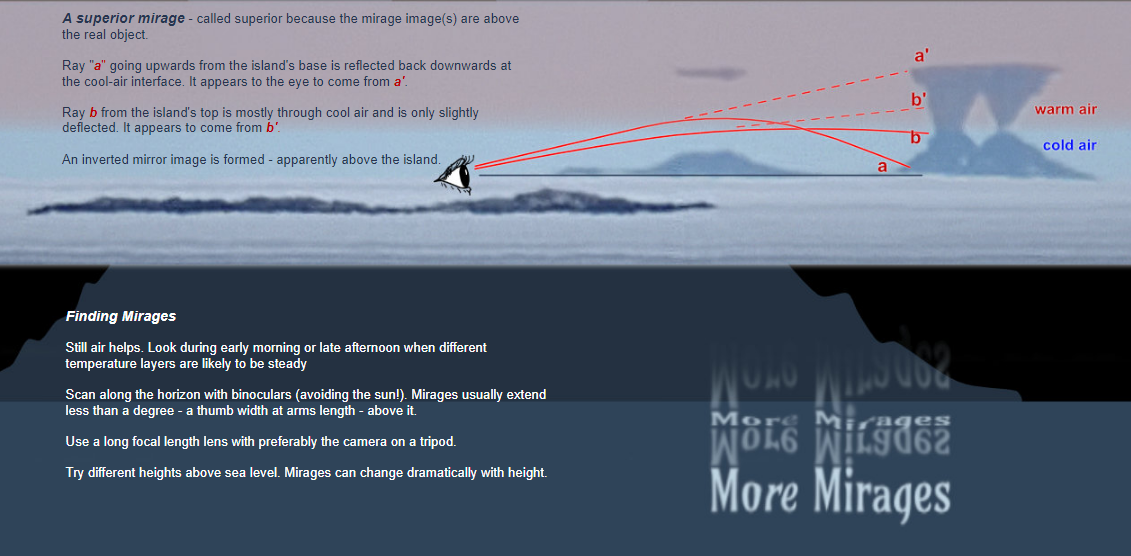Greenland Superior Mirages
Greenland Superior Mirages: A Phenomenon of Optical Illusion
Greenland, with its stunning landscapes and icy terrains, is not only a sight to behold but also a hub for atmospheric optical phenomena. Among these captivating phenomena are Greenland superior mirages, which create mesmerizing illusions in the sky. In this article, we will delve into the intriguing world of superior mirages, exploring their formation, characteristics, and how to spot them.
Superior mirages occur when a horizontal air layer acts as a reflective surface, creating the illusion of mirrored mountains and inverted islands hanging upside down in the sky. It is as if a colossal horizontal mirror stretches across the heavens, distorting our perception of reality. This optical illusion arises from the interaction between cold and warm air layers, where the junction between them acts as a mirror, reflecting light in unexpected ways. However, it is important to note that other complex refraction effects may also contribute to the formation of these mirages.
The lower layer of the superior mirage is often observed as a dark band, which may give the impression of a dirty atmosphere. However, this darkness can be attributed to the refraction process itself, as the lower layer absorbs more light due to its greater density. The lower layer of air may originate from the cold air sliding off the Greenland ice sheet or from the cooling effect of the nearby sea.
One fascinating aspect of superior mirages is their ability to create inverted mirror images that appear above the real objects. This is why they are referred to as "superior" mirages since the mirage images are situated above their corresponding physical counterparts. To understand this phenomenon better, let's consider the paths of light rays.
When a light ray travels from cold, dense air into warmer, less dense air, it always deflects towards the colder air. In the case of superior mirages, this boundary between air layers is exceptionally sharp, causing the light ray to be reflected back into the cool air. The ray that originates from the base of the island appears to come from a point above it, marked as "a'". Similarly, the ray from the top of the island only experiences a slight deflection and seems to emanate from a point above, denoted as "b'". The combination of these rays creates an inverted mirror image, creating the illusion of an elevated image above the actual object.
To witness the enchanting spectacle of Greenland superior mirages, there are a few tips to keep in mind:
- Optimal viewing conditions include still air, preferably during the early morning or late afternoon when temperature layers are more likely to remain stable.
- Scan along the horizon with binoculars, but be cautious not to gaze directly at the sun. Superior mirages typically extend less than a degree above the horizon, approximately equivalent to a thumb width at arm's length.
- For photography enthusiasts, using a long focal length lens and mounting the camera on a tripod can enhance the capture of these optical illusions.
- It is also worth experimenting with different heights above sea level, as mirages can exhibit significant variations based on altitude.
In conclusion, Greenland superior mirages offer a captivating glimpse into the realm of atmospheric optics. These illusions, created by the interplay of cold and warm air layers, astound viewers with their mirrored landscapes and inverted images. By understanding the mechanisms behind their formation and employing the right observation techniques, one can unlock the secrets of these elusive phenomena. So, keep your eyes peeled during your next visit to Greenland and prepare to be entranced by the mesmerizing dance of superior mirages in the Arctic sky.
Note: This article has been automatically converted from the old site and may not appear as intended.


Greenland Mirages
Sections of a large panorama of distant mountains and islands taken by Markus Wildi from Sissimuit on the western coast of Greenland. Markus identified the two miraged islands as 70km distant.
There is a horizontal air layer sometimes visible as a dark band. Within it are mirrored mountains. Reflected islands hang upside down. It is though a giant horizontal mirror stretches across the sky.
That is exactly what is happening. A junction between cold and warm air layers reflects light like a mirror. Other complex refraction effects could also be operating.
The lower colder air slid off the Greenland ice sheet only a few miles distant. Or the sea cooled it. The lower dark layer is not necessarily dirty, although it could be as the glacier tips are notoriously dusty. The refraction process itself leads to greater light absorption in the lower layer.
Image @Markus Wildi, shown with permission
Light passing from cold dense air into warmer less dense air ALWAYS deflects towards the
cold air. Here the boundary is unnaturally sharp.
When the boundary is diffuse and the temperature difference is great enough, the ray is mirrored back into the cool air.

A superior mirage - called superior because the mirage image(s) are above the real object.
Ray "a" going upwards from the island's base is reflected back downwards at the cool-air interface. It appears to the eye to come from a'.
Ray b from the island's top is mostly through cool air and is only slightly deflected. It appears to come from b'
An inverted mirror image is formed - apparently above the island.
Finding Mirages
Still air helps. Look during early morning or late afternoon when different temperature layers are likely to be steady
Scan along the horizon with binoculars (avoiding the sun!). Mirages usually extend less than a degree - a thumb width at arms length - above it.
Use a long focal length lens with preferably the camera on a tripod.
Try different heights above sea level. Mirages can change dramatically with height.
Note: this article has been automatically converted from the old site and may not appear as intended. You can find the original article here.
Reference Atmospheric Optics
If you use any of the definitions, information, or data presented on Atmospheric Optics, please copy the link or reference below to properly credit us as the reference source. Thank you!
-
<a href="https://atoptics.co.uk/blog/greenland-superior-mirages/">Greenland Superior Mirages </a>
-
"Greenland Superior Mirages ". Atmospheric Optics. Accessed on April 20, 2024. https://atoptics.co.uk/blog/greenland-superior-mirages/.
-
"Greenland Superior Mirages ". Atmospheric Optics, https://atoptics.co.uk/blog/greenland-superior-mirages/. Accessed 20 April, 2024
-
Greenland Superior Mirages . Atmospheric Optics. Retrieved from https://atoptics.co.uk/blog/greenland-superior-mirages/.